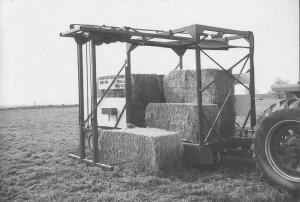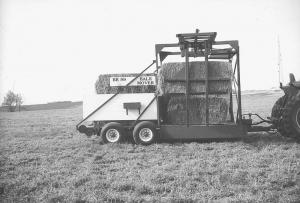2007 - Volume #31, Issue #4, Page #32
[ Sample Stories From This Issue | List of All Stories In This Issue | Print this story
| Read this issue]
Big Bale Retriever Works Fast On Older Tractor
 |
 |
"I wanted to be able to run with the lay of the field, not crossing it to pick up bales," says Breuer.
His patent pending bale mover has a channel iron frame with walking beam axles on either side. On his prototype, the floor consists of 2 by 12-ft. boards with a web of chains powered by a hydraulic motor. A hydraulic-powered carriage on top raises and lowers a bale lift mechanism to pick bales off the field and move them onto the bed. The 6-ft. wide by 17-ft. long bed holds eight bales and the bale lift holds a ninth bale during transport.
Breuer wanted a bale mover that could be easily used on older tractors with only two hydraulic valves and limited flow. With hydraulics powering the bale pickup carriage, he uses the pto to power a pump to run the motor on the bed chain.
"I can use the hydraulics lever to pick up the bales and set them on the bed and then start the PTO when I want to move the bales back to make room for more," explains Breuer.
Picking up a bale is as simple as driving alongside. A short "stop" arm sticks out from the side of the bed to catch and guide the bale as it is being picked up. It ensures the bale is centered on the lift mechanism spears.
As Breuer approaches the bale, he runs the carriage out to the end of the overhead structure. The bale lift is then lowered into place. When the bale is in position against the stop bar, the carriage is retracted, forcing the bale spears into the bale. At that point, the bale is lifted up and into position on the bed.
The entire process is controlled by a roller chain that loops from a reel down the length of the overhead track and then down to the lift mechanism and back. When Breuer engages the hydraulic-powered reel, it moves the carriage out and away and lowers the lift into place for the next bale. When the hydraulics are re-engaged, the process is reversed and the bale is loaded into place. When the first four bales are stacked, the pto is engaged to move them to the rear.
Unloading is even easier. Breuer drives the mover to the storage area, engages the pto and drives ahead as the bales are pushed off the open back end.
"When I do shorter 5 1/2-ft. bales, I can carry 13 of them," explains Breuer. "I can even load three large round bales. When loading the shorter bales, I flip over a section of tubing hinged to the stop bar. This centers the shorter bale on the spears for even loading."
The overhead structure is fabricated from steel tubing with angle iron for track. The entire track and support rails are 15 ft. 4 in. long (the width of the bed, plus enough length to extend the carriage with its bale lift and spears beyond the width of the big bale waiting to be picked up). Breuer designed the track to fold back at the 11-ft. point for easier road transit and maneuvering around buildings and other equipment.
While his prototype works well with no wear on the drive chain or other components, Breuer is already at work on a second-generation machine. He will extend the 8-ft. 1-in. bale opening on the side by 5 in. to allow for slightly longer bales. He is considering extending the bed to allow for picking up and moving 13 large square bales at a time. As he builds it, he will be carefully tracking time and materials.
"I am guessing a unit like this first one would be priced between $26,000 and $28,000," says Breuer. "I am in the process of building a few just to get the word out, but I am not interested in building and marketing them."
He has a videotape and pictures available for people interested in purchasing a unit or in fabricating and marketing.
Contact: FARM SHOW Followup, Raymond Breuer, P.O. Box 215, Patch Grove, Wis. 53817 (ph 608 994-2922; cell 608 604-7225).

Click here to download page story appeared in.

Click here to read entire issue
To read the rest of this story, download this issue below or click here to register with your account number.




